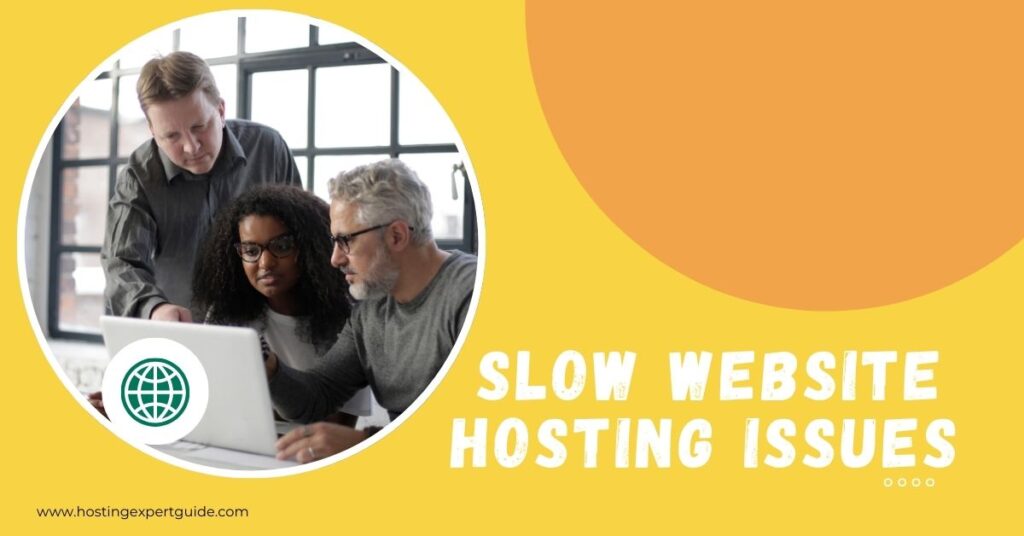While many factors contribute to slow load times, a surprising number of performance bottlenecks stem from your hosting environment. And, in today’s fast-paced world, a sluggish website can cost you visitors, conversions, and credibility.
So, in this guide, we’ll explore the top 10 slow website hosting issues and provide clear, actionable fixes to get your site back up to speed.
Understanding Slow Website Hosting Issues

Before diving into specific problems, it’s helpful to understand why hosting plays such a critical role in site performance. Every time someone visits your site, their browser makes requests to your web server.
If your hosting provider can’t handle those requests quickly—due to limited resources, poor configuration, or outdated software—you’ll see longer load times, timeouts, and frustrated users.
Common slow website hosting issues include inadequate server resources, overcrowded shared hosting, and a lack of caching or CDN support. By diagnosing and addressing each of these areas, you can dramatically improve your site’s speed and reliability.
Top 10 Web Hosting Issues & Fixes
#1. Inadequate Server Resources
Your plan may not provide enough CPU, RAM, or I/O throughput, causing slow response under load. Shared plans and entry-level VPS packages often come with strict limitations on processing power and memory. If your website has outgrown these limits due to increased traffic, more plugins, or heavier scripts, performance will suffer.
Fix:
#1. Upgrade your plan to one with more dedicated CPU and memory. Consider moving from shared hosting to VPS or a dedicated server if your traffic is consistently high.
#2. Monitor resource usage via your hosting dashboard or tools like New Relic, Datadog, or cPanel metrics. This helps pinpoint resource exhaustion.
#3. Optimize applications to use fewer resources by compressing images, deferring non-critical scripts, and disabling unused plugins or themes.
#4. Enable lazy loading for images and videos so that non-critical content loads only when the user scrolls.
#5. Consider code minification and bundling to reduce file sizes and server workload.
By ensuring you have sufficient hardware, you eliminate one of the most common slow website hosting issues and lay the foundation for long-term scalability.
#2. Overcrowded Shared Hosting
Issue: On shared hosting, noisy neighbors can consume disproportionate resources, slowing your site. Even if your website is well-optimized, other sites on the same server may impact your performance.
Fix:
#1. Switch to VPS or cloud hosting for dedicated resources and better isolation. These environments ensure your site is not affected by others.
#2. Choose hosts with resource isolation guarantees and transparent overselling policies.
#3. Review host reputation for consistent performance under shared environments, and read user reviews or independent benchmarks.
#4. Use tools like Bitcatcha to analyze how long it takes for your host to respond globally. Poor response times may suggest overloaded servers.
#5. Ask your hosting provider if your current plan includes CloudLinux or other containerization technologies that help isolate accounts.
Upgrading from shared plans resolves many slow website hosting issues tied to resource contention, especially if your site is resource-intensive or experiences traffic spikes.
#3. Insufficient Bandwidth and Network Throttling
Limited network throughput or throttling can choke data transfer, especially during traffic spikes. Some hosts enforce bandwidth caps or slow down connections after usage thresholds are reached.
Fix:
#1. Select plans that offer unmetered or high bandwidth to accommodate growth and heavy traffic periods.
#2. Use a Content Delivery Network (CDN) to offload traffic and distribute content globally, reducing the burden on your origin server.
#3. Test network speed with tools like Speedtest, Pingdom, or WebPageTest. Look for high latency or packet loss during peak hours.
#4. Consult your host’s fair use policy (FUP) to ensure they’re not throttling your connection unfairly.
#5. Optimize media files to reduce bandwidth consumption. Tools like TinyPNG or ImageOptim can help
Addressing bandwidth constraints is key to avoiding slow website hosting issues when visitors flood in. Fast data transfer rates help maintain a smooth user experience.

#4. Outdated Server Software
Running old versions of Apache, Nginx, PHP, or database engines can degrade performance and security. Legacy software often lacks optimizations present in newer versions.
Fix:
#1. Enable automatic updates for your server stack to stay current with patches and performance enhancements.
#2. Migrate to PHP 8.x (or the latest stable release) for significant speed gains, including better memory usage and JIT compilation.
#3. Use modern web servers like Nginx or LiteSpeed for better concurrency, lower latency, and improved request handling under load.
#4. Regularly audit your server stack to ensure compatibility with plugins, themes, or scripts.
#5. If you’re on managed hosting, check that your provider updates backend technologies regularly.
Keeping your stack current prevents many slow website hosting issues related to inefficiency. Plus, it strengthens your site against known vulnerabilities.
#5. Lack of Caching Mechanisms
Every page view triggers full page rendering and database queries, even for static content. This redundancy significantly slows performance.
Fix:
#1. Implement server-level caching (e.g., Varnish, Nginx FastCGI cache) to store rendered pages and bypass backend processing.
#2. Use application caching plugins (e.g., WP Rocket, W3 Total Cache for WordPress) to cache HTML, CSS, JS, and even database queries.
#3. Leverage object caching with Redis or Memcached to store reusable data structures in memory.
#4. Use browser caching via .htaccess or server config files to control how assets are stored on the user’s device.
#5. Audit your site’s cache headers and expiry settings using developer tools or performance audits to ensure assets are properly cached.
Proper caching eliminates repetitive processing and solves frequent slow website hosting issues. It’s one of the most impactful performance optimizations.
#6. No Content Delivery Network (CDN)
Visitors far from your origin server experience high latency, slowing page loads. This is especially true for sites with global traffic.
Fix:
#1. Integrate a CDN (Cloudflare, KeyCDN, AWS CloudFront) to serve assets from edge locations.
#2. Configure origin pull so your server only handles cache misses, reducing load and response time.
#3. Optimize CDN settings: enable Brotli or GZIP compression, HTTP/2 or HTTP/3 support, and minification of assets.
#4. Use CDN analytics to monitor cache hit ratios and tweak your cache-control headers for improved performance.
#5. Host heavy assets (videos, large scripts) on your CDN to free up your server bandwidth.
A CDN is one of the most effective defenses against slow website hosting issues caused by geographic distance. It also adds security benefits like DDoS protection.
#7. Poorly Configured DNS
Sow DNS resolution adds latency before the browser can even connect to your server. This is often a hidden performance issue.
Fix:
#1. Switch to a fast DNS provider like Cloudflare DNS, Google Cloud DNS, or Amazon Route 53.
#2. Reduce DNS lookup time by minimizing the number of unique hostnames used on a page (e.g., fewer third-party scripts).
#3. Set low TTLs (Time to Live) during migrations or changes, then increase for stability and faster caching.
#4. Use DNS monitoring tools to check for propagation delays and performance bottlenecks.
#5. Implement DNSSEC (Domain Name System Security Extensions) to add a layer of security without sacrificing speed.
Fast, reliable DNS is often overlooked yet critical for preventing slow website hosting issues. It’s the first step in the page load process.

#8. Absence of GZIP or Brotli Compression
Uncompressed assets increase payload size, slowing transfers. This affects HTML, CSS, JavaScript, and JSON files.
Fix:
#1. Enable GZIP or Brotli on your web server or via CDN settings. Brotli offers better compression ratios for text files.
#2. Verify compression with online tools (e.g., GIDNetwork, Check GZIP Compression, or GTmetrix waterfall tab).
#3. Compress text-based assets like HTML, CSS, JavaScript, and SVGs.
#4. Avoid compressing already-compressed files (e.g., JPEG, PNG, MP4) to save CPU cycles.
#5. Use build tools like Webpack or Gulp to automate compression during your deployment pipeline.
Compression reduces data transfer times, directly tackling common slow website hosting issues. It’s a low-cost, high-impact solution
#9. Inadequate Database Optimization
Large, unindexed tables and inefficient queries slow down dynamic content generation. WordPress and other CMS platforms are especially vulnerable.
#1. Index frequently queried columns and remove unused indexes to maintain optimal search speed.
#2. Optimize queries by avoiding SELECT * and using indexed JOINs and WHERE clauses.
#3. Use database profiling tools to identify slow queries (e.g., MySQL EXPLAIN, Query Monitor for WordPress).
#4. Schedule regular maintenance (e.g., OPTIMIZE TABLE in MySQL or VACUUM in PostgreSQL).
#5. Consider moving to a managed database service that handles performance tuning and scaling automatically.
#6. Archive old data that doesn’t need to be accessed in real-time to reduce query complexity.
A lean database ensures your server can respond swiftly, eliminating many slow website hosting issues. It also scales better under load.
#10. Geographic Distance to Server
The farther a visitor is from your server, the higher the latency. Even milliseconds add up when multiple assets are involved
Fix:
#1. Deploy multi-region servers or use geo-load balancing to direct users to the nearest data center.
#2. Implement a global CDN to cache content near users and reduce time-to-first-byte (TTFB).
#3. Consider anycast DNS for faster initial connections.
#4. Analyze geographic performance with tools like GTmetrix location testing or Pingdom’s global speed test.
#5. Offer alternate language and geo-targeted versions of your site if you serve a multilingual audience to reduce server-side processing per region.
Minimizing physical distance is a straightforward way to avoid slow website hosting issues for global audiences. It’s especially important for international businesses and content-rich websites.
Key Takeaways and Best Practices
#1. Audit regularly: Use tools like GTmetrix, Lighthouse, or WebPageTest to spot hosting‑related bottlenecks.
#2. Leverage managed services: Managed VPS or cloud hosting often includes performance tuning and security hardening.
#3. Automate maintenance: Schedule backups, software updates, and database optimizations to run automatically.
#4. Monitor proactively: Set up alerts for CPU, memory, disk I/O, and network usage to catch slow website hosting issues before they impact users.
Final Thoughts
Tackling slow website hosting issues is not a one‑time fix but an ongoing process of monitoring, optimization, and strategic upgrades.
By addressing the ten areas above—from server resources and caching to DNS and geographic considerations—you can transform a sluggish site into a high‑performance platform that delights visitors and supports your goals.
Remember, the best hosting environment is one that aligns with your traffic patterns, budget, and technical expertise.
Whether you’re running a simple blog or a high‑traffic eCommerce store, understanding and resolving slow website hosting issues will keep your site fast, secure, and ready for whatever the web throws at it.

